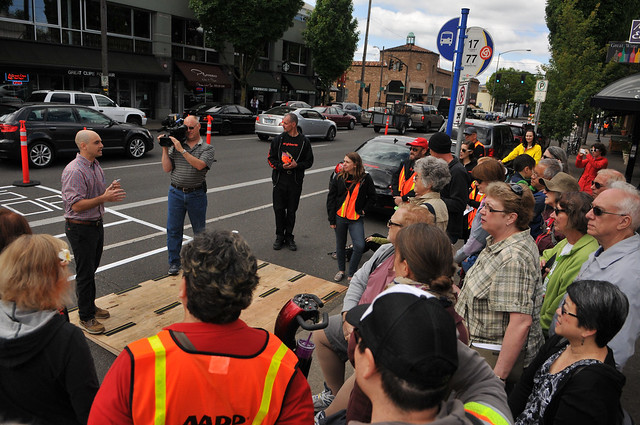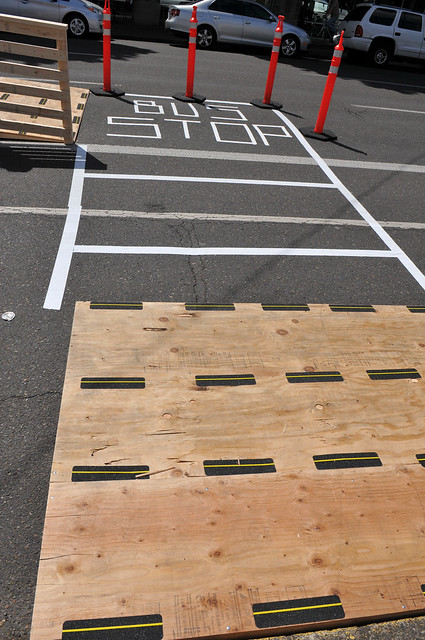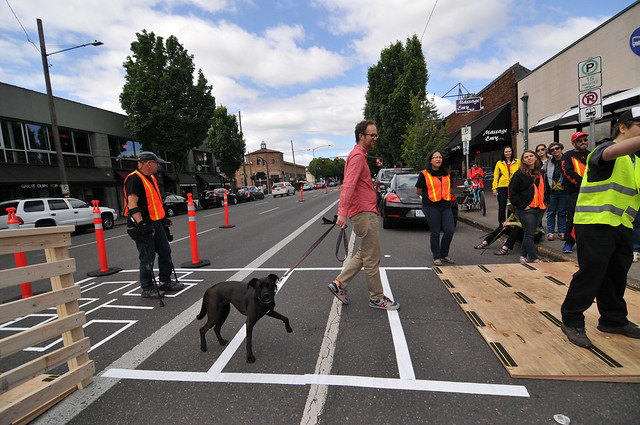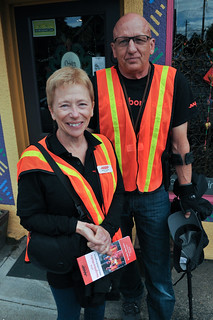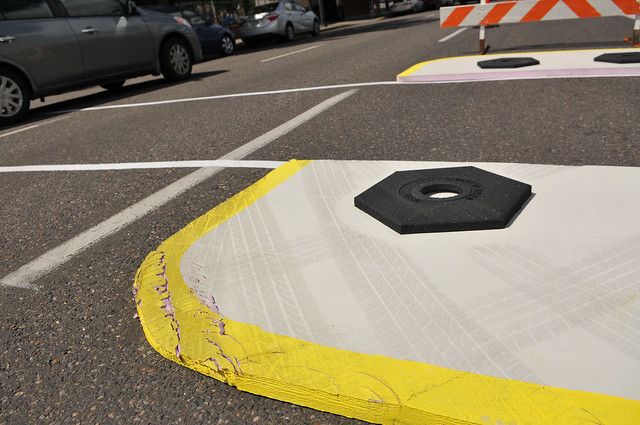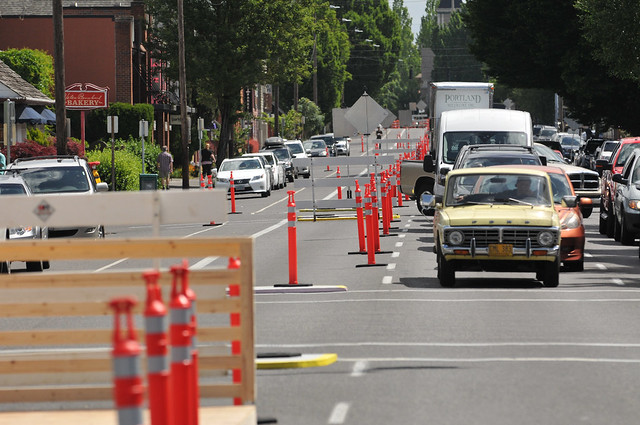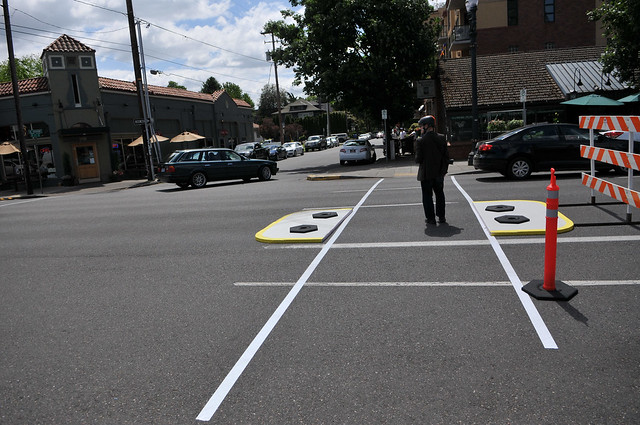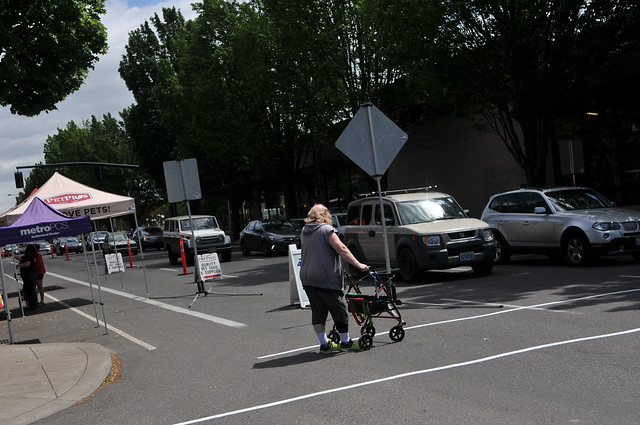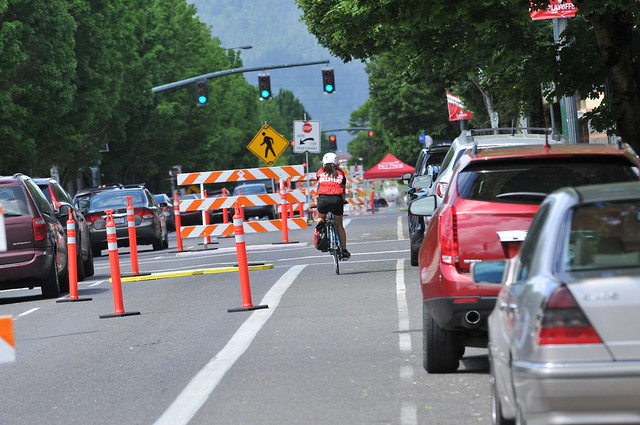
(Photos: J. Maus/BikePortland)
The gutsiest tactical urbanism project Portland has ever seen is officially underway.
“The corridor is so wide the potential is really untapped. We have so much historic character along the street, but it’s drowned out by three lanes of traffic.”
— Steve Cole, president of the Irvington Community Association
Last night nearly four dozen volunteers transformed Northeast Broadway for about a mile between 24th and 7th by adding 12 new crosswalks, median islands and a protected bike lane. It’s all part of the “Better Broadway” project spearheaded by Better Block PDX and a host of other community and advocacy groups in close partnership with the Portland Bureau of Transportation.
The goal of the project is to “turn a mean street into a main street,” organizers say, by changing the configuration of Broadway from an auto-centric thoroughfare to a more enjoyable environment where shoppers, bikers, and walkers have more room to breathe.
I rode in the new lane this morning and it was indeed much-improved. Instead of a door-zone on my right and fast auto traffic on my left, I meandered and window-shopped as I rode down the street. And because of the narrower roadway and new crosswalks, people are driving much slower.
Broadway’s old cross-section was the classic urban arterial: six lanes with two on-street auto parking lanes, three standard lanes, and a standard bike lane. As of this morning Broadway still has six lanes, but only two of them are standard vehicle lanes. There’s now a larger protected bike lane and a curbside lane that’s open for cafe tables and walking. One auto parking lane remains the same and the other was supposed to be “floating” to act as a buffer between moving auto traffic and the bike lane, but that feature wasn’t ready as of this morning (organizers are planning to tweak the design a bit more tonight).
At a launch event this morning we heard from Better Block, the Broadway-Weidler Alliance and other project partners. Kathryn Doherty-Chapman with Go Lloyd (a group that promotes biking, walking and transit in the Lloyd District) said stores and restaurants on the north side of the street (closest to residential neighborhoods) get twice the business of the south side simply because people don’t like to cross the street. Doherty-Chapman said her hope is that the Better Broadway project creates conditions, “Where crossing the street doesn’t feel like a life or death choice.”
Commissioner Steve Novick’s Transportation Policy Advisor Timur Ender spoke in front of a temporary floating bus island at NE 16th — the first ever in Portland. Volunteers have laid down an ADA-compliant curb ramb near the existing curbside bus stop that goes into a new crosswalk. The crosswalk leads bus riders up onto a wooden platform where they wait for the bus. This allows the bus operator to service the stop without having to drive across the bikeway (this is the design the city wanted on North Williams). “This was a risk for TriMet,” Ender said. “But they went along with it.”
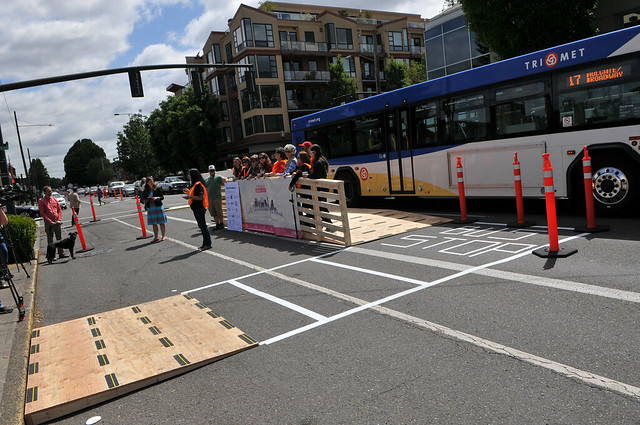
Ender, a former volunteer with Better Block PDX, spoke about the spirit of the project. “Our streets are made with concrete and stone, but they don’t have to be set in stone.” This willingness to take risks and try new things on our streets is at the core of these “Better” projects.
Ray and Nancy Tanner agree. They were at the event as volunteers with the Oregon chapter of AARP. “Some things you just need to try out,” they told me during a walking tour of the project prior to the press conference. “The more heads you get together, the more ideas you get. The city planners don’t always have the best answers.” Ray Tanner, who walks with crutches on both arms said projects usually just meet the minimum ADA requirements. “But those are just minimums! This project challenges the minimums.”
Steve Cole, president of the Irvington Community Association is also happy to see the project. “In the long-term, we’d like to see Broadway right-sized. This used to be a de-facto highway,” he continued as people drove slowly and traffic backed up on the street. “We’d like to see this as a destination for tourists. The corridor is so wide the potential is really untapped. We have so much historic character along the street, but it’s drowned out by three lanes of traffic.”
At around noon that traffic had come to a standstill and was backed-up for several blocks.
As of this morning project organizers said they still had several tweaks they need to make. The intention was to have the northside parking lane “floating” in the street and acting as a buffer between moving auto traffic and the bikeway. A press release for the project promised a “street fair” atmosphere for the entire week where there would be, “outdoor seating, music, activities, art, and more.” But the temporary striping and signage isn’t robust enough so people are still parking curbside. This means more bikeway blockage and businesses aren’t able to put their tables and chairs in the former parking lane. As of this morning only three businesses had taken advantage of the curbside space.
Advertisement

Another goal of the project is to avoid traffic jams. Today at around noon people in cars were backed-up for several blocks. This encouraged unpredictable turns (people bailing on Broadway and opting for neighborhood streets instead) and other dangerous behaviors — not to mention that there’s a risk that congestion will be the image that captures most of the media and public attention.
“It’s just ludicrous… You’ve already got a bike lane. What more do bicyclists need? A pedicure on every corner? Massage tables?”
— John Olson, local resident
John Olson lives a few blocks away. He couldn’t believe his eyes. “This is a completely ill-conceived idea,” he told me during an interview. Olson thinks having two standard vehicle lanes instead of three is a “cockamamie” idea. “Traffic in Portland is awful, I don’t see how this makes it any better. It’s just ludicrous on the face of it.” Olson told me he bikes and walks in the neighborhood and would love for Broadway to be more like Mississippi or Alberta (thriving commercial corridors with narrow, two-way streets). I asked him why he wouldn’t want his own neighborhood street to feel as comfortable and walkable as those. “This just isn’t like those streets, they were naturally like that. Broadway was built like this for a reason. There’s a lot of traffic studies that went on to put three lanes here. And now, with traffic getting worse, we’re just going to do a complete 180? Look at this! It’s backed up and this is noon, imagine what this will look like in the morning!”
When I pointed out that maybe a reconfigured Broadway would encourage people to drive less, he scoffed at that idea. “Until you can rip people out of their cars – probably by force,” he said, “You’re talking about social engineering.” “Forcing people out of their cars is a concept I generally agree with, but still… What are we going to do, get rid of I-5 too? Things need to move man! This is just going to create more problems than it will address.”
As for making the bikeway safer and more appealing to more people, Olson said (with a smile), “You’ve already got a bike lane, what more do bicyclists need? A pedicure on every corner? Massage tables?”
Is Better Broadway what you need? Give it a ride next time you’re in the neighborhood and let us know what you think.
— Jonathan Maus, (503) 706-8804 – jonathan@bikeportland.org
Our work is supported by subscribers. Please become one today.


